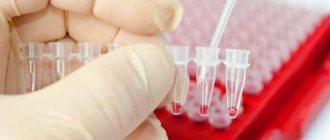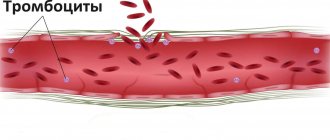A stool test for carbohydrates is a laboratory test that is performed on infants and children under 2 years of age. The main objective of the procedure is to detect the presence of lactase deficiency. And also such testing makes it possible to detect some pathologies of the gastrointestinal tract.
Today, stool analysis for carbohydrates can be done both in municipal clinics and in private medical centers. In order for the study to show a reliable result, parents need to first understand the rules for collecting biomaterial.
General information
Impaired absorption of carbohydrates in the small intestine - malabsorption - is a sign of enzymatic deficiency, which can be either hereditary or acquired.
The most common type of malabsorption is lactase deficiency - lactose intolerance, i.e. the body's inability to break down and absorb milk sugar. Congenital lactase deficiency manifests itself already in the first months of a child’s life and is characterized by a sharp delay in weight gain. In adulthood, the acquired form is most often diagnosed. Less commonly observed is a malabsorption of sorbitol alcohol, fructose, trehalose, and sucrase-isomaltase.
Regardless of the type of enzymatic deficiency, the accumulation of large amounts of undigested carbohydrates in the intestines manifests itself in the same way:
- spasmodic pain (colic) in the abdomen, provoked by impaired intestinal motility;
- increased gas formation due to increased fermentation of bacterial microflora;
- diarrhea, the cause of which is the retention of a large amount of fluid in the lumen of the intestinal tube (osmotic effect);
- signs of intoxication of the body: headaches and dizziness;
- general weakness and lethargy;
- nausea and vomiting;
Malabsorption may also be temporary. Often this condition develops after an intestinal infection or an acute inflammatory process, serious operations on the gastrointestinal tract, etc. An ill-designed diet can also affect the speed and extent of carbohydrate absorption. For example, increased sorbitol content in familiar foods can impair the absorption of fructose.
Meaning and decoding
Analysis of carbohydrate content is simple and informative. You can take it in almost every clinic in Moscow and other large cities. In order for the decoding of the information received to be reliable, it should only be carried out by an experienced specialist. When deciphering, the doctor first of all pays attention to the carbohydrate content.
This indicator is basic, since in case of lactase deficiency, the child’s body slows down their breakdown. In this case, carbohydrates are eliminated from the body during bowel movements. Normally, the amount of carbohydrates in a baby’s stool should not exceed 1%; as they grow older, the figure should gradually decrease. For children less than 6 months old, the normal value ranges from 0.5 to 0.6%.
Indications for analysis
The analysis is interpreted by a gastroenterologist, therapist, pediatrician or general practitioner.
- Chronic diarrhea and digestive disorders in adults;
- Headaches, apathy and weakness, lack of body weight,
- Stomach disorders without established causes;
- Previously identified malabsorption in adults;
- Diagnosis of congenital lactase deficiency in infants under one year of age;
- Lack of required weight gain in newborns.
An analysis of carbohydrate content in feces is a fairly informative diagnostic test. However, based on its results, only the total (total) amount of all carbohydrates can be assessed. It is not possible to calculate the concentrations of lactose, fructose, glucose and other sugars separately.
What may serve as an indication for research?
The need to determine the amount of carbohydrates in a person's stool may be necessary to determine how well carbohydrates are absorbed by the body. This is due to the fact that in the process of growing up, there is an increase in the diversity of the diet. As a result, this creates some strain on the functioning of the digestive organs. Such an examination is carried out in order to determine whether the body contains elastase necessary for normal functioning. A test for its digestibility is carried out together with a check to see if there are carbohydrates in the feces.
A stool test for elastase is carried out at the slightest suspicion that the breakdown of the elaxin protein has ceased. Moreover, this will pose some danger to the development of the human body, due to the development of diseases such as:
- cholelithiasis;
- diabetes mellitus;
- pancreatic injuries;
- lactose tolerance.
Norm of carbohydrates in feces
| Patient age | Amount of carbohydrates |
| Children under 1 year | 0 – 0,25% |
| Children over 1 year old and adults | Not detected |
Note: in children of the first year of life the following deviations from the norm may be observed:
- 0.3 – 0.5% (insignificant);
- 0.6 – 1% (average);
- more than 1% (significant).
Factors influencing the result:
- Violation of the rules for preparing for analysis;
- Errors when collecting biomaterial;
- Features of the daily diet;
- Patient's age;
- Genetic factors and family history;
- Intestinal infection or inflammation;
- Taking prebiotics, antibiotics and other drugs.
Rules for collecting biomaterial
If the baby is already about a year old and knows how to sit on a potty, then the procedure for collecting material for stool analysis does not cause much trouble for parents. You just need to wash the children's pot well and pour boiling water over its inner surface. Then the child is placed on it to have a bowel movement.
The resulting material is not needed in its entirety; a volume of 1-2 teaspoons is sufficient for analysis. Feces should be packed in a special container or small glass jar with a lid, pre-washed and scalded with boiling water.
In very tiny children, collecting stool for analysis is somewhat more difficult. They defecate often and little by little, and their semi-liquid stool is absorbed into the diaper. It will be easier to collect the required amount of stool if you put a regular cotton diaper on your baby. The second way is to lay the baby undressed on an oilcloth and help him empty himself by massaging his tummy or bending and unbending his legs.
Carbohydrates in feces are increased
- Enzyme (lactase) deficiency;
- Chronic diseases of the small intestine: Crohn's disease (granulomatous inflammation of the gastrointestinal tract);
- celiac disease (impaired breakdown of gluten), etc.;
What influences the indicators
The carbohydrate content in a baby's feces of 0.2-0.4 is considered a minor deviation. Even with such an excess, the pediatrician can make adjustments to his diet and, if necessary, prescribe certain medications.
The causes of increased carbohydrates in the feces of infants are various disorders of intestinal functionality. These include:
- Imbalance of intestinal microflora.
- Enzymatic insufficiency of the pancreas, characterized by disruption of the absorption and breakdown of carbohydrates.
- Congenital intolerance to disaccharides.
- Transient lactase deficiency, in which the production of the enzyme decreases (due to damage to enterocytes). It is this form of lactose disaccharide intolerance that most often causes an increase in carbohydrates in the stool in children under one year of age. Pathology develops due to exposure to rotavirus.
If carbohydrates in a baby’s stool are elevated, do not immediately panic. The pathology is easily treatable, despite serious clinical manifestations. In some cases (rarely) the result is false positive. There are several reasons for this:
- Incorrect collection of biomaterial: feces taken from a diaper, non-compliance with storage rules.
- On the eve of the test, the child was fed a low-lactase formula.
- Use of antibacterial drugs during the test.
Preparing for analysis
To obtain reliable research results, the following preparation rules must be observed:
- 3 days before the analysis, exclude the use of rectal suppositories and cleansing enemas;
- a week before the procedure, stop taking medications: those that affect the character of stool (antidiarrheals, laxatives);
- increasing peristalsis (pilocarpine, belladonna);
- containing coloring pigments (barium, bismuth, iron, etc.);
- exclude colored (red and green) vegetables/fruits, juices from them, ketchup and tomato paste, alcohol from the diet;
A mandatory condition is not to undergo diagnostic tests with contrast (X-ray, CT, MRI, etc.) 2-3 days before the analysis.
How to prepare for a stool test for carbohydrates
The result will be as reliable as possible if the baby’s stool is collected correctly. It is necessary to feed a newborn in his usual way. The diet cannot be changed a few days before the material is collected; it should be normal for the child. It is not advisable to introduce new foods into the diet.
If the child is breastfed, this rule fully applies to the mother. You should not take any medications for several days prior to a stool test for carbohydrates. They are permissible only if absolutely necessary for the health of the baby.
Material for analyzing stool for carbohydrates is taken naturally, without an enema or drugs to facilitate bowel movements. To collect feces from a baby who can already sit on the potty, the latter should be washed with baby or laundry soap, scalded with boiling water, and dried. Feces from very young children should be collected from the most sterile oilcloth. Biomaterial scraped from the inside of a disposable diaper or fabric (sheets, diapers) is not suitable for analyzing stool for carbohydrates.
For analysis, a volume of stool equal to approximately one teaspoon is enough. The mixture should be collected in a clean container with a lid. It should close tightly, preventing air from entering there. It is advisable to purchase a container with a stick for collecting material. Similar special containers are sold in pharmacies. Their cost is relatively low. After collection, the box should be delivered to the laboratory within four hours. The countdown begins after the act of defecation.
How to collect stool
Lactose allergy in breastfeeding infants
To make the analysis results more credible, it is necessary to ensure the correct collection of biomaterial. In this case, feces that end up on the diaper will not work - the liquid fractions will be absorbed into the pad, and the residue will not give a clear picture. It is better to use these options:
- a clean oilcloth should be placed under the newborn toddler, without covering it with cloth, or a plastic bag;
- It’s good if there is a children’s bedpan in the house;
- the child, who is already holding his head, is placed on a disinfected potty.
Having received the biomaterial, it is collected in a special container. There is no need to place all the collected feces; the container is filled to no more than 1/3 of the volume (but not less than 1 tsp). It is enough to make a fence with a disposable spatula in 4-5 places, the rest can be thrown into the toilet. If the stool is quite liquid, it is poured into a container of no more than 5 ml and the container is tightly closed with a lid.
Stool container
The procedure is carried out on an empty stomach, not forgetting to wash the baby first. The material must be submitted for research on the day it is collected, but no later than 4 hours after the procedure. The container should be stored in the refrigerator (away from the freezer) until it is sent to the laboratory.
On the container, in addition to the child’s name and date of birth, it is necessary to indicate the day and time of stool collection for carbohydrate analysis.
Where can I get tested?
Before going for a diagnosis, you need to see a doctor. A child with symptoms of lactase deficiency should be shown to a pediatrician. After the initial examination, a referral for analysis is issued.
You can test feces for carbohydrates at a clinic or private laboratory. Diagnostic results are ready 3-5 days after the procedure.
Fecal analysis for carbohydrates is a diagnostic method used in pediatrics to identify lactase deficiency and other pathologies of the digestive system. Before collecting material for research, the diet is adjusted and medications are excluded. The results reflect the amount of carbohydrates in the stool, which indicates the presence or absence of disease.
Monitoring lactase deficiency
Children with congenital lactose intolerance are forced to follow a lifelong diet and take medications containing the enzyme lactase. In the transient form of the disease, the prognosis for recovery is favorable. Most children return to breastfeeding and tolerate foods containing milk sugar normally.
The sufficient effectiveness of treatment is judged by the child’s weight gain, disappearance of dyspeptic symptoms, and normal rates of mental and physical development. After completing the course, the doctor prescribes a repeat test for carbohydrates.
If your baby experiences the first symptoms of lactase deficiency, you should immediately contact your pediatrician. Poor absorption of sugars can be a consequence of serious pathologies. Delay in treatment contributes to the transition of the disease to a chronic form that is difficult to treat.
Additional tests
If a child has undigested carbohydrates, it is necessary to consult a pediatric gastroenterologist and infectious disease specialist. To clarify the diagnosis, they may prescribe additional tests, for example:
- glycemic load test with lactose;
- genetic research;
- breath test.
The most informative is the study of samples of the small intestinal mucosa obtained through biopsy. However, the use of this method is limited due to its complexity and invasiveness. Doctors resort to it only under strict indications.
Doctors do not make a conclusion that a child has lactase deficiency based on clinical manifestations and the results of one test. To confirm the pathology and prescribe adequate therapy, the pediatrician prescribes a comprehensive examination:
- Coprogram. The analysis evaluates the ability to digest food and the enzymatic activity of the digestive organs.
- Biopsy of the colon mucosa. Using a biopsy, samples of biomaterial are obtained for further histological examination.
- Analysis for dysbacteriosis. Various pathogenic organisms can interfere with the normal absorption of lactose.
- Clinical blood test. An increased level of ESR and leukocytes suggests the presence of an inflammatory process.
- Blood for biochemistry (glucose level, bilirubin).
- Immunoglobulin E test.
- Fecal analysis for helminthiasis.
Additional Research
To make a diagnosis of lactase deficiency, the doctor first takes into account the clinical picture.
Moreover, one or two manifestations of pathology are not enough. All clinical signs of deficiency must be present. Important information may be the presence of a similar pathology in the family, the disappearance of diarrhea when replacing milk with a dairy-free formula. The diagnosis is confirmed by additional laboratory tests:
- Stool pH is less than 5.5;
- positive analysis of the child's stool for carbohydrates;
- no increase in blood glucose concentration after a lactose load.
The most informative test is the quantitative determination of lactase activity in a biopsy of the small intestinal mucosa. But this is a painful, complex and expensive test, so it is not usually prescribed.
Reasons for deviations
Reduced lactase activity is observed in 2/3 of children born. In most cases this does not lead to illness. By 2-3 months of life, the enzyme begins to work at full strength.
In full-term children under one year of age, in the majority of cases, lactose intolerance is caused by overfeeding, intestinal immaturity and (or) its pathologies. In premature babies, low lactase activity is detected in almost everyone. Most often, it is in these cases that the doctor recommends a stool test for carbohydrates.
Lactose intolerance due to overfeeding is explained by excess milk sugar in the child's intestines. Although the amount and activity of the enzyme are normal, they are not enough to break down the carbohydrate supplied with excess milk. Undigested lactose is transported in large quantities into the large intestine, leading to diarrhea and other characteristic symptoms.
Most often, this condition is observed when feeding “on demand”. Lactose overload is of particular importance in the development of symptoms in infants born prematurely or exposed to hypoxia during labor. Dr. Komarovsky considers overfeeding to be the main reason for diagnosing lactose intolerance and ordering a stool test for carbohydrate content.
In children born at 28-30 weeks of pregnancy, the small intestine has not matured morphologically and functionally. Gradually, the intestine matures and enzyme activity returns to normal.
Acquired (secondary) lactose intolerance is quite common. Its causes are most often acute intestinal infections: rotavirus, salmonellosis, or the use of antibiotics and other drugs (anabolic steroids).
An increase in the amount of carbohydrates in feces is characteristic of lactase deficiency, as well as disorders of the absorption of other sugars.
If there is a low or moderate deviation of the test result from the norm, the child should be monitored and, over time, another study, as well as an acidity test, should be prescribed. If the carbohydrate content is more than 1% and the clinical picture is present, lactase deficiency is diagnosed in the baby and appropriate treatment is prescribed.











